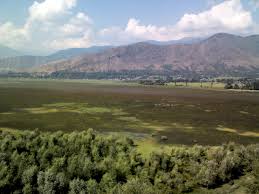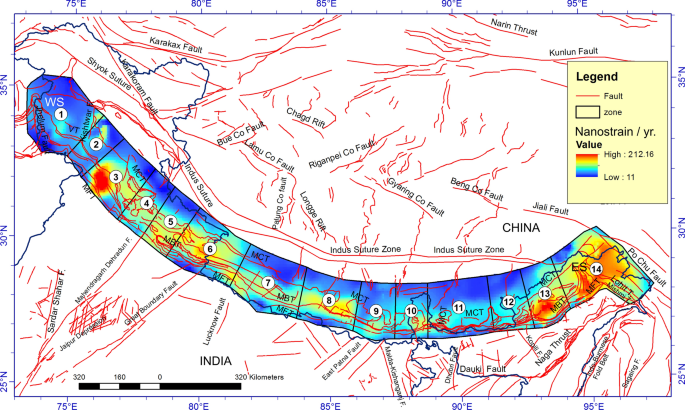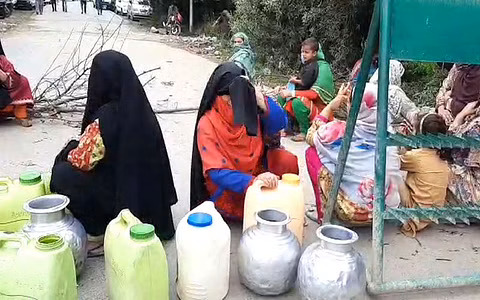The Wular Lake has shrunk in size and its water carrying capacity has been reduced as government has failed to work out conservation measures.
 The illegal constructions, garbage dumping and massive silting of the lake has hampered the conservation efforts. Due to the widespread encroachments, the lake left many areas inundated in the floods last September.
The illegal constructions, garbage dumping and massive silting of the lake has hampered the conservation efforts. Due to the widespread encroachments, the lake left many areas inundated in the floods last September.The massive silting of the lake and dumping of waste by local bodies and growing encroachments in absence of proper government monitoring has left the lake piolluted.
As per official records 20 villages with thousands hectares of cultivable land were washed out in floods last year, as the water carrying capacity has declined considerably.
“During the rains the water from the lake flows out on roads and enters the localities. The problem gets worsened due to encroachments and dumping of waste,” said a local resident of Kanibathi village, which saw a massive devastation in the 2014 floods as large swathes of paddy land remained under water.
The residents of the areas of Nusoo, Bangiyari Hajin and Sumbal said that the local municipalities are dumping garbage into the lake and the government has failed to take any “ stringent action against local bodies officials.”
Government has not been able to remove millions of willow trees around the lake, which has decreased its retaining capacity. Earlier a report was submitted by the Environmental Impact Assessment team of University of Kashmir which alerted over the growth of trees and asked for immediate removal of trees in order to increase the water retaining capacity of the lake.
There are 25 lakhs of willow trees (1000 per hectare) while government under the Comprehensive Management Area Plan have removed about 30,000 in last four years.
According to official reports forest department has so far removed 26500 tress from compartment 1,2,3,4,5 and 6 collecting revenue of about 3 crore, while Rakhs and Farms department has removed about 3500 trees.
Following the court directions issued in the Public Interest Litigation (PIL), the Environment department mapped out the area in 2012 recording that it had a perimeter of 84 kilometres and is spread on 130 square kilometers.
The survey revealed an average elevation 1577.5 M msl of nsl (Normal Sea level) in critically silted and plantation areas and to arrive at a level of 1576 msl and it requires average dredging of 1.5 meters to enhance water holding capacity of the lake.
Though the state government after the preparation of comprehensive management action plan (CMAP) worth Rs 386 crore in 2007 slashed the funds to Rs 120 corer under the 13-th Finance Commission award, following which the Wular Conservation Management Authority (WUCMA) was constituted in 2012 for utilisation of conservation funds.
However the funds proved insufficient when government applied geo spatial techniques for lake measurement and following the stationing of 1159 pillars carried out ETS (Electronic total Station) / GPS (Geographic Positioning System) surveys of 7 square kilometre of lake for dredging. During the survey it was found that the area requires Rs 300 crore budget for dredging to restore the lake.
“The readings of ETS and GPS demand 300 crore of budget for the dredging of surveyed area of 7 square kilometre while government has approved 120 crore for dredging 130 square kilometre total demarcated area of lake,” said an expert in WUCMA.
He said that Centre and state government should revise the project cost so that Wular Lake can be saved from deterioration.
In absence of proper budget, WUCMA has selected critically silted hotspots for dredging near Malengam Rakh and Jhelum Basin near Banyari. Authority is working on 19 Sections and 7 plantations blocks to reduce the siltation by deploying the local machinery and has not procured any heavy dredging machinery.
The pollution has badly affected the aquatic ecosystem in the Wular leading to near extinction chesnut and fish. The fishermen extracting Nadroo and Chesnut say that recent floods have led to the decline in Nelumbium (nadroo)and chestnut, while the fish produce has fallen. The population of 40,000 spread over villages of Lankrishipora, Lherwalpora, Saderkot, Kulhama, Ajas, Zoorimanz, Shagund, Madvan, Kanibathi, Khenusa, Zalwan, Hajin, Shahgund and other adjoining villages were dependent on the Wular Lake once considered as the chief source of Kashmiri Nelumbium (Nadroo). Villagers said that the production has now seen a slump.
“Nadroo is now extinct from the Wular, Few years ago we were extracting tons of Nadroo from the Wular Lake” said Ghulam Hassan.
“Kashmiri Nelumbium (Nadroo) is famous in whole India here the market was good for the Nadrroo Business, but the rising water level due floods proved a slaughter for our ancestral trade”Hasan said.
The foods and extreme weather events had badly affected the Wular Lake, the biggest chestnut shipper in the state, as it had failed to produce chestnut crop from last two seasons.
“Bad weather conditions and floods in the Wular lake has caused immense damage to both the quantity and quality of the chestnut crop,” said an extractor Ghulam Muhammad.
“Most of the area in the Wular Lake which witnesses the abundant growth of chestnut plant is barren this year as the pollution and poisonous material draining into the Lake has caused decomposition of plants,” he said.
Amid inclement weather the fish production in the Wular has also got affected. Fishermen community in the area while alleging government apathy said that government has failed to act after recent floods while the massive pollution and rampant construction around river Jehlum has led to destruction of Fish habitat inside the Lake, that has caused the depleting fish production.
Decades ago, this world famous fresh water lake was teeming with gigantic fish, they said.
“The map of the lake have changed dramatically from last two years with immediate fall in the fish production” said Ghulam Hassan Dar a fishermen.
“Before ten years there was plentiful fishes swarming in the lake, we were catching hundreds of Kilograms of fish daily, now it depletes to few Kilograms, even some fishermen came empty handed after days of work” Dar said.
It is here pertinent to, mention that Wular Lake was catering about 60% of valley’s fish requirement, which has drastically reduced now.
When contacted Chief Executive WUCMA Nisar Ahmed Darzi said that the Technical Committee has directed to have phased manner removal of trees
He said that prompt cutting of trees can led to eutrophication so we are going for phased manner removal.
On lack of funds, he implied that the concerned committee had taken note of it and may request for review of the project cost.






